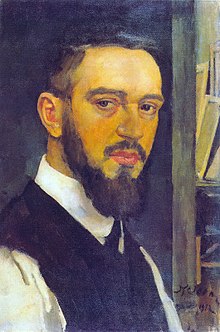Konstantin Fyodorowitsch Juon
Konstantin Yuon ( Russian Константин Фёдорович Юон * 12 . Jul / 24. October 1875 greg. In Moscow ; † 11. April 1958 ) was a Russian-Soviet painter, stage designer and art theorist.
biography
Konstantin Juon was born in the family of the Swiss- Russian insurance employee Theodor Friedrich Juon in Moscow . The Reformed family came from the municipality of Masein in the canton of Graubünden . His brothers were Paul Juon , a well-known composer, and Eduard Juon, a Russian mining engineer and officer, who both later moved to Switzerland. From 1892 to 1898 Juon studied at the Moscow Art School a. a. with Konstantin Sawizki , Konstantin Korowin and Abram Archipow . After completing his studies, he took private lessons between 1898 and 1900Valentin Serov . During several stays in Western Europe and Paris , he came into contact with the works of impressionists such as Camille Pissarro , but retained his own characteristic style.
In 1900 Juon opened the first private painting and drawing school in Moscow. He later taught at the Leningrad Academy of Arts and the Moscow Surikov Art Institute . His students included u. a. Alexander Kuprin , Vladimir Faworsky and Wera Muchina . He designed sets for the Moscow Chudoschestwenny Teatr and the Maly Teatr . He also worked on opera performances. In 1903 Juon was one of the founders of the Russian Artists Association (Союз русских художников) and he was a member of the Mir Iskusstva artists' association .
During the Soviet era , Juon was director of the art-theoretical research institute at the Academy of Arts from 1948 to 1950 and first secretary of the Soviet Union of Artists from 1956 to 1958. In 1943 he was awarded the Stalin Prize, an Order of Lenin and other awards. Since 1951 he was a member of the CPSU . Konstantin Juon died in Moscow on April 11, 1958 and was buried in the Novodevichy Cemetery.
plant

Konstantin Juon began his artistic work as an impressionist landscape and genre painter with a symbolist coloring. The symbolist influence is most evident in the Creation of the World cycle (1908–1912), which has the creation story as its theme, and in The New Planet (1921), a painting depicting the October Revolution as a cosmic catastrophe.
In his landscape painting he mixed elements of Palekh and icon painting . Juon's late work was determined by socialist realism , such as the parade on Red Square on November 7, 1941 (1949).
literature
- Борисовская, Н. А. / Гордон, Е. С. (Ed.): Русские художники от А до Я . Москва: Слово 2000. ISBN 5850502319 . P. 210. (Russian)
- Tatiana Karpova, Catherine Lepdor: Magic you paysage russe. Chefs-d'œuvre de la Galerie nationale Trétiakov, Moscou. préfacé par Frederik Paulsen, Irina Lébédéva et Bernard Fibicher, Musée cantonal des Beaux-Arts / 5 Continents, Lausanne / Milano, 2014.
Web links
- Literature by and about Konstantin Fjodorowitsch Juon in the catalog of the German National Library
Individual evidence
- ^ Roman Bühler: Paul Juon. In: Historical Lexicon of Switzerland . March 25, 2010, accessed July 23, 2020 .
- ^ Roman Bühler: Eduard Juon. In: Historical Lexicon of Switzerland. March 25, 2010, accessed July 23, 2020 .
| personal data | |
|---|---|
| SURNAME | Juon, Konstantin Fjodorowitsch |
| ALTERNATIVE NAMES | Юон, Константин Фёдорович (Russian) |
| BRIEF DESCRIPTION | Russian artist |
| DATE OF BIRTH | October 24, 1875 |
| PLACE OF BIRTH | Moscow |
| DATE OF DEATH | April 11, 1958 |
| Place of death | Moscow |
